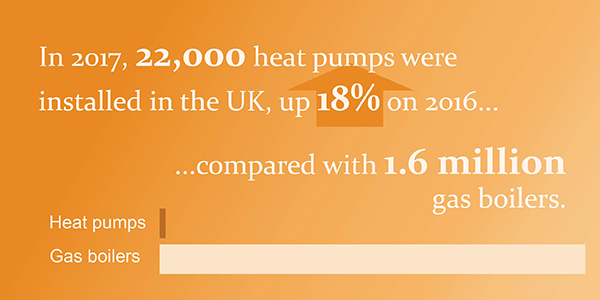
 |
Dr Nick Kelly 20 September 2018 |
The phrase “electrification of heat” has appeared in a large number of UK foresighting and policy documents over the last decade, with grand ambitions to provide heat for our buildings through decarbonised electricity and a move away from gas boilers. The vehicle for this transformation? The humble heat pump, a tried and trusted technology, whose sibling, the fridge sits in almost every kitchen.
Heat pumps extract heat energy from low temperature ambient sources such as the outside air or the ground and transform it into usable heat for our homes, consuming a little bit of electricity in the process. So, if this electricity is carbon free, we decarbonise domestic heat. In their 2011 ‘Gone Green’ scenario, National Grid envisaged that there could be over a million domestic heat pumps providing low-carbon heat to our houses by 2020, whilst the UK Committee on Climate Change hoped that 70% of carbon savings from heating could come from conversion to heat pumps.
So, how have these bold ambitions turned out?
The decarbonisation of electricity in the UK has proceeded apace with the carbon content of grid electricity falling from over 480 gCO2/kWh in 2010 to around 280 gCO2 in 2017. In parallel, in 2017 there were 22,000 UK heat pump installations in the UK - a figure 18% higher than the year before.
But, in the same year there were 1.6 million gas boiler installations and around 26 million dwellings in the UK have gas central heating. So, whilst electricity is steadily decarbonising, we have fallen far short of those early, optimistic predictions of millions of heat pumps providing low-carbon heat for our homes.
Yet, if we look to continental Europe can see a very different picture. In Switzerland, heat pumps account for over 35% of total heating systems and the majority of new heating system installations. In Sweden around 20% of domestic heat is sourced from heat pumps and in France annual sales of heat pumps exceeded 140,000 in 2015.
Why is the UK lagging behind?
This isn’t an easy question to answer, as there are multiple reasons.
The first stumbling block for those wishing to install a heat pump is cost. Installing the cheapest heat pump technology – an air-source heat pump - will cost upwards of £6K. A ground source heat pump installation will cost upwards of £10K. By contrast, a high-efficiency condensing gas boiler will cost around £2.5K. In these cash-constrained times, what possible incentive is there to choose a heat pump over a gas boiler? What about the Renewable Heat Incentive (RHI)? Is 10p/kWh of heat produced for air source or 20p/kWh from ground source really going to persuade a householder to pay thousands more upfront for their heat source?
A second major stumbling block is practicality. Contrary to popular opinion, heat pumps are not a straight replacement for gas boilers. Typically, they produce hot water at 40-50oC compared to 80-90oC from a boiler. The result is that you’ll need bigger radiators and/or to insulate your house to a higher standard to achieve the same level of comfort. So in addition to paying more for your heating source, you’ll also likely need to undertake remedial works on your home and heating system.
Finally, the skills of the UK installer base are focused on boilers. The operation and control of heat pumps is subtly different and this may explain the frequent poor performance of heat pumps in trials such as those run by the Energy Savings Trust – whilst heat pump technology is mature and robust, effective operation requires that they are properly installed and operated in homes. This is not always the case.
Meeting 2050 emission reduction targets
As we move closer to 2050 and the need to decarbonise becomes ever more pressing, can we make up for lost time? The answer to this question is, yes. As the examples of smart phones or domestic photovoltaic installations show - if a technology is attractive enough, or there are the right incentives in place, then we can see explosive growth.
However, heat pumps are no iPhone - domestic heating lacks the “X factor” of smart, hand-held electronics. So, cost and incentives would be required to drive the market. But as we’ve seen, heat pumps cost too much and the incentive through RHI is too meagre to really drive growth. So, unless the are significant cost reductions and proper rewards for householders and building owners to move away from gas, the widespread electrification of heat will remain a policy maker’s dream.
Want to continue the conversation? The next Centre for Energy Policy Energy Conversation, "How feasible is the ambition to dramatically reduce energy demand in our non-domestic buildings?" takes place on Thursday 4 October, 6pm-8pm. Visit our event page for more information and to register.
Tags: News & Blogs